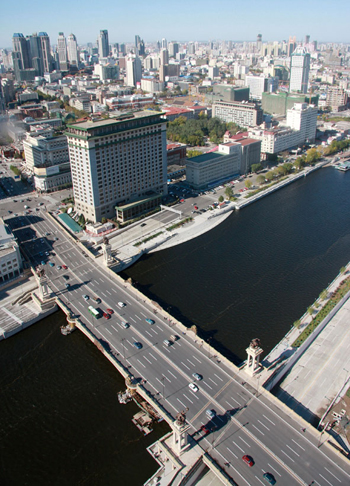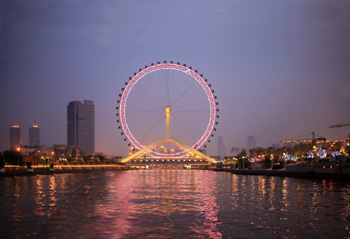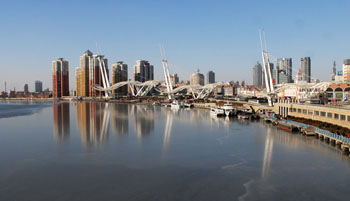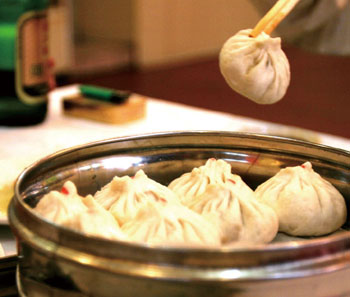Written by: Sun Sixin
Posted on: October 24, 2012 |  | 中文
| 中文
Tianjin, or “Jin” for short, borders Beijing the capital city of China, on the northwestern side. The city is one of the country’s four municipalities under the central government, and is the biggest industrial and commercial port city of Northern China. It is the third biggest metropolis of the country, and ranks as the world’s 15th largest city. Tianjin is a famous historical and cultural center. As one of the first cities awarded with the title “Outstanding Tourist City of China,” it is also praised and known as “the Pearl of Bohai Sea.”
Sun Sixin
 Tianjin, or “Jin” for short, is one of China’s four municipalities under the central government and a famous historical and cultural city of China. In the year 2004, the city celebrated its 600th founding anniversary.
Tianjin, or “Jin” for short, is one of China’s four municipalities under the central government and a famous historical and cultural city of China. In the year 2004, the city celebrated its 600th founding anniversary.
The word “Tianjin” was first given by Emperor Ming Chengzu Zhu Di of the Ming Dynasty in the first year of Yong Le (1402 A.D.). The name means, “the ferry-place for the emperor.” At the time, the capital city Beijing needed its food and cloth to be transported from regions south of the Yangtze River, so Tianjin became a port from where a shipping line was opened. The following year, the Ming government established a fort in Tianjin; hence the name “Tianjin Wei (Fort of Tianjin).” Building a fort in Tianjin was meant to provide protection for Beijing by stationing troops there. It was also intended to attract business people who would establish themselves in the area and thereby help develop the city.
Tianjin sits on the western coast of the Pacific, towards the northeast of the rich land of the North China Plain, facing the roaring Bohai Sea in the east and the rolling Yan Mountains in the north. The city borders Beijing on the northwest, covering an area of 11,000 square kilometers, with the sixth longest river of China, the Hai River, running through it.
The city is the economic hub that connects Northeast, Northwest, East, and Mid-South China. At 120 km from Beijing, it stands at the mid-point of China’s golden north coast. It is the port for the vast territory of North and Northwest China, the axis of the two fan areas that open North China to the world, and the east station on Euro-Asian Continental Bridge that is closest to the next stop.
As the grandest comprehensive trading port of North China, equipped with the country’s biggest containers port, Tianjin trades with over 170 countries and regions, constituting more than 300 ports, all over the world. In addition Tianjin Binhai International Airport has a huge number of domestic and international flights, making it the No.1 freight transportation center of North China. Its railway stations connect Beijing-Shandong and Beijing-Shanghai, two of the country’s most significant railway lines. Its highway network extends in all directions and has a well-built and preserved traffic infrastructure. That is to say, a comprehensive, modern three-dimensional transportation network centered on the port has taken form in Tianjin.
 As one of the first outstanding tourist cities of China, Tianjin is endowed with rich tourist resources. Wuda Dao (Five Big Avenues) is an expression of genuine Tianjin culture. What Wuda Dao is to Tianjin is what hutong is to Beijing. A deeper understanding of Tianjin Culture can be achieved by a visit to Nankai University and Tianjin University. Featuring modern architecture, Nankai University was the mother school of the nation’s former beloved Premier Zhou Enlai. The “ancient culture street” has the most archaized buildings. The total 80 buildings on the street are all one-story or two-story high edifices decorated with paintings, brick-carvings and wood-carvings in themes of classical Chinese literature, myths, and folklores.
As one of the first outstanding tourist cities of China, Tianjin is endowed with rich tourist resources. Wuda Dao (Five Big Avenues) is an expression of genuine Tianjin culture. What Wuda Dao is to Tianjin is what hutong is to Beijing. A deeper understanding of Tianjin Culture can be achieved by a visit to Nankai University and Tianjin University. Featuring modern architecture, Nankai University was the mother school of the nation’s former beloved Premier Zhou Enlai. The “ancient culture street” has the most archaized buildings. The total 80 buildings on the street are all one-story or two-story high edifices decorated with paintings, brick-carvings and wood-carvings in themes of classical Chinese literature, myths, and folklores.
Both its architecture and its culture carry the traits of an immigration city. Thanks to the immigration that came about as a result of shipping, business, a famine at the beginning of the city’s foundation, and the movement of military troops, the city bears all the hallmarks of an amalgamation of cultures. According to linguists, the “mother tongue” of the Tianjin dialect may find its origin in the regions of Yangtze and Huai, having taken its form from the complex population of the city.
When talking about Tianjin, every Chinese thinks of its most famous food: da mahua, the big fried dough twist, and Goubuli stuffed buns. The beautiful Nirenzhang Coloured figure, the Yangliuqing Spring Festival, quyi (a Chinese folk art form) and cross talks also come to mind. Since 1644, tea houses, story-telling houses, and theatres emerged continually in and around Tianjin port. Performers from other places came here and local operas like Hebei Opera and Pingju (a local opera of North China) found their stages here, and it is believed that Tianjin was a lucky place for the arts. Songs full of identical local tunes became popular, making Tianjin China’s famous “land of quyi”. Shehuo, a popular local community-based performance activity, also has a long history; it has been carried on across generations and has been seen held in townships and villages till the present times. In addition, the learning of martial arts is very popular among the people. Huo Yuanjia, the kungfu icon in countless Hong Kong movies and TV series, was from Tianjin.
 Also known as “marketplace culture,” the port culture of Tianjin is a hospitable one. It is also reckoned that “?”?wei?or Tianjin culture featured with folk culture, “?” (jing) or the “capital” culture represented by Beijing, and “?”?hai?or “sea” culture represented by Shanghai are the most identical and, simultaneously, the most competitive cultures of China.
Also known as “marketplace culture,” the port culture of Tianjin is a hospitable one. It is also reckoned that “?”?wei?or Tianjin culture featured with folk culture, “?” (jing) or the “capital” culture represented by Beijing, and “?”?hai?or “sea” culture represented by Shanghai are the most identical and, simultaneously, the most competitive cultures of China.
Goubuli Stuffed Bun:
As an old local saying goes, “one is not said to have toured in Tianjing without tasting Goubuli stuffed buns”. Goubuli is a representative food of the city with a history of over a hundred years. The restaurant was founded by Gao Guiyou, whose infant name was “Gouzi” (literally meaning “doggie”). In the early times, Chinese parents preferred infant names of lower meaning such as “Gouzi” and “Shitou (stone)” so that evil spirits wouldn’t bother their baby: even dogs wouldn’t look at the child, let alone devils. But customers became fond of “Gouzi’s buns”. His buns were so popular that he couldn’t spare a single minute to chat with people while he worked. Therefore, people joked about him, “If Gouzi is selling buns, don’t be mad if he can’t hear you.” As days went on, his stuffed buns and “hearing problems” - “buli (ignoring people)” - became famous and thus this saying became the brand name of the buns.
Da Mahua:
 Mahua is made of dough dotted with sweet osmanthus, ginger, sugar, chopped green plum, walnuts and sweet orange peel. It is covered in sesame and fried in hot oil till it is golden in colour. Mahua can also be enjoyed with other sweets. In 2002, Tianjin Guifaxiang Mahua Food Group Co. Ltd. signed a contract with the American corporation Compas to open stores in the United States and bring its products to America.
Mahua is made of dough dotted with sweet osmanthus, ginger, sugar, chopped green plum, walnuts and sweet orange peel. It is covered in sesame and fried in hot oil till it is golden in colour. Mahua can also be enjoyed with other sweets. In 2002, Tianjin Guifaxiang Mahua Food Group Co. Ltd. signed a contract with the American corporation Compas to open stores in the United States and bring its products to America.
Tianjin Cross Talk:
Cross talk is a traditional Chinese folk art between two people, which necessitates a mastery of four basic techniques: speaking, imitating, entertaining, and singing. Tianjin is the port of cross talk. Its traditional cross talk performance can be traced back to the 1900s and it is a fond pastime of Tianjin locals. If you take a taxi, you may enjoy a cross talk the entire time because the drivers are particularly fond of it. The Tianjin youth is also fond of this traditional art. You may find many young people in cross talk theatres or tea houses. Some of them worship cross talk performers as if they were pop stars and can even recite some lines of their favorite performers’ cross talks.
Although the art originated in Beijing in the Qing Dynasty (1644-1911), it flourished in Tianjin; hence the saying “cross talk was born in Beijing but was made popular by Tianjin.” It is also the reason why the performers must go to Tianjin if they want a promising career. They cannot perceive of gaining entry to the cross talk circles of Beijing if Tianjin doesn’t recognize their achievement. Many well-known performers, including Hou Baolin and Ma Sanli, all started with Tianjin and later came to be known by the entire nation.
You may also like: